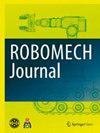Dynamic manipulation of unknown string by robot arm: realizing momentary string shapes
IF 1.7
Q3 INSTRUMENTS & INSTRUMENTATION
引用次数: 2
Abstract
We propose a method to realize the dynamic manipulation of a string with unknown characteristics via a high-speed robot arm. We use a mass-spring-damper model for the string and repeat three steps: motion generation, real manipulation, and parameter estimation. Robot motion is given by the joint angular velocities expressed by the Bezier curves. Their control points are randomly positioned to generate various robot motion for dynamic string manipulation. The generated motion is performed by a wire-driven robot arm and, real string movement is captured by the camera. These time-series images are used for the parameter estimation of string. The best parameter set is determined via comparison between real and simulated string movement after changing parameter randomly and logarithmically. This parameter set is not unique, but it simulates the actual string movement well. Since the estimated string parameter is used for the robot motion generation after repeating the above 3 steps, the motion generation reflects string property and motion objective can success without special tests in advance. This is an advantage of our method because it is difficult to know all of string property with very complicated non-linearity beforehand. We focus on realizing the momentary string shape in 2 dimensions in this paper. We confirmed the effectiveness of our proposed method by realizing five momentary shapes and 3 kinds of string properties. We also discussed the reproducibility and compatibility of estimated parameters and motion generation.机械臂对未知弦的动态操纵:实现瞬时弦形
提出了一种利用高速机械臂实现对未知特征弦的动态操纵的方法。我们使用质量-弹簧-阻尼器模型,并重复三个步骤:运动生成、实际操作和参数估计。机器人的运动由贝塞尔曲线表示的关节角速度给出。它们的控制点是随机定位的,以产生各种动态字符串操作的机器人运动。生成的运动由线驱动的机械臂执行,真实的字符串运动由相机捕捉。这些时间序列图像用于弦的参数估计。在随机和对数变化参数后,通过比较真实和模拟的弦运动来确定最佳参数集。这个参数集不是唯一的,但是它很好地模拟了实际的弦运动。由于重复上述3步后,机器人运动生成使用的是估计的弦参数,因此运动生成反映了弦的属性,运动目标无需事先进行特殊测试即可成功。这是我们的方法的一个优点,因为事先很难知道非常复杂的非线性字符串的所有性质。本文主要研究二维瞬态弦形的实现。通过实现5种瞬时形状和3种弦性质,验证了该方法的有效性。我们还讨论了估计参数和运动生成的再现性和兼容性。
本文章由计算机程序翻译,如有差异,请以英文原文为准。
求助全文
约1分钟内获得全文
求助全文
来源期刊

ROBOMECH Journal
Mathematics-Control and Optimization
CiteScore
3.20
自引率
7.10%
发文量
21
审稿时长
13 weeks
期刊介绍:
ROBOMECH Journal focuses on advanced technologies and practical applications in the field of Robotics and Mechatronics. This field is driven by the steadily growing research, development and consumer demand for robots and systems. Advanced robots have been working in medical and hazardous environments, such as space and the deep sea as well as in the manufacturing environment. The scope of the journal includes but is not limited to: 1. Modeling and design 2. System integration 3. Actuators and sensors 4. Intelligent control 5. Artificial intelligence 6. Machine learning 7. Robotics 8. Manufacturing 9. Motion control 10. Vibration and noise control 11. Micro/nano devices and optoelectronics systems 12. Automotive systems 13. Applications for extreme and/or hazardous environments 14. Other applications
 求助内容:
求助内容: 应助结果提醒方式:
应助结果提醒方式:


